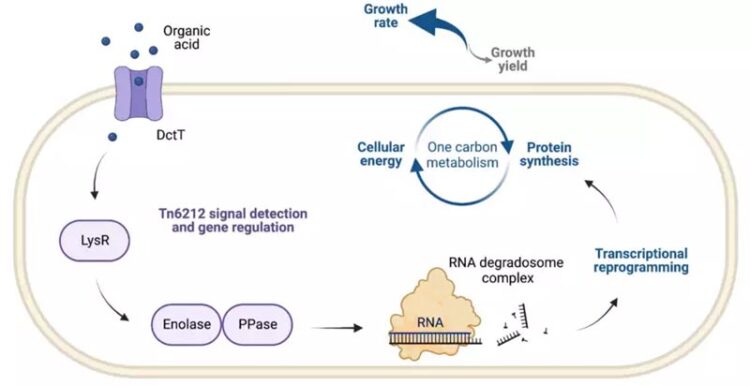Can genetic parasites alter interactions between microbes and hosts?

Cellular consequences of transposon manipulation of host metabolism.
© MPI for Evolutionary Biology
Researchers from the Max Planck Institutes (MPI) for Evolutionary Biology in Plön and for Biology in Tübingen have made significant progress in understanding the evolution of interactions between plants and microbes. The study focusses on Pseudomonas syringae, a globally distributed plant pathogen, and in this instance the harm done to kiwifruit production.
Outbreak of a new lineage of Pseudomonas syringae pv. actinidae (Psa) has caused devastating plant disease in kiwifruit worldwide. The disease is a major limiting factor for kiwifruit cultivation and production globally, manifesting as necrotic spots on leaves, cankers, branch and stem dieback, wilting of branches and necrosis of flowers. Population genomics analyses by MPI researchers in Plön and Tübingen have previously shown that the global outbreak is due to a pandemic sublineage that emerged from a more diverse population native to South East Asia. Separate introduction events of this clonal sublineage has caused outbreaks in almost all kiwi growing regions worldwide.
Interestingly, during global spread of the pandemic sublineage, researchers detected three independent events in which genetic parasites invaded the the pandemic clone. Surprisingly, the parasitic elements, carried even smaller genetic parasites known as transposons. The latter have spread worldwide in recent time. Such rapid spread led the researchers to ask about the function of the genes carried on the transposon and whether these might be contributing to disease. The answer surprised all involved: the transposon was found to be controlling genes on the host bacterium, manipulating the host for its own benefit. And one of those benefits is an increase in the population size of the bacterium, which is detrimental to the plant, but ultimate benefits the transposon.
Professor Dr Paul B. Rainey, Director of the Department of Microbial Population Biology at the Max Planck Institute for Evolutionary Biology in Plön, underlined the importance of these findings: “Our results show that in even the simplest organisms, interactions not just among organisms, but also among genetic components that compose organisms, are strikingly complex and can have difficult to anticipate consequences for community function.”
The research findings were recently published in an article in the Proceedings of the National Academy of Sciences (PNAS) and not only contribute to a deeper understanding of plant-microbe interactions, but also have potential implications for the development of disease control strategies in agriculture. The Max Planck Institute for Evolutionary Biology in Plön and the Institute of Biology at the University of Tübingen are continuing their collaboration to further decipher the evolution and interactions of microorganisms.
Wissenschaftliche Ansprechpartner:
Paul B. Rainey
Director
Department of Microbial Population Biology
Max Planck Institute für Evolutionary Biology
Originalpublikation:
https://doi.org/10.1073/pnas.2309263121
https://www.evolbio.mpg.de/3740257/news_publication_21694100_transferred?c=15503
Media Contact
All latest news from the category: Life Sciences and Chemistry
Articles and reports from the Life Sciences and chemistry area deal with applied and basic research into modern biology, chemistry and human medicine.
Valuable information can be found on a range of life sciences fields including bacteriology, biochemistry, bionics, bioinformatics, biophysics, biotechnology, genetics, geobotany, human biology, marine biology, microbiology, molecular biology, cellular biology, zoology, bioinorganic chemistry, microchemistry and environmental chemistry.
Newest articles

Innovative 3D printed scaffolds offer new hope for bone healing
Researchers at the Institute for Bioengineering of Catalonia have developed novel 3D printed PLA-CaP scaffolds that promote blood vessel formation, ensuring better healing and regeneration of bone tissue. Bone is…

The surprising role of gut infection in Alzheimer’s disease
ASU- and Banner Alzheimer’s Institute-led study implicates link between a common virus and the disease, which travels from the gut to the brain and may be a target for antiviral…

Molecular gardening: New enzymes discovered for protein modification pruning
How deubiquitinases USP53 and USP54 cleave long polyubiquitin chains and how the former is linked to liver disease in children. Deubiquitinases (DUBs) are enzymes used by cells to trim protein…



